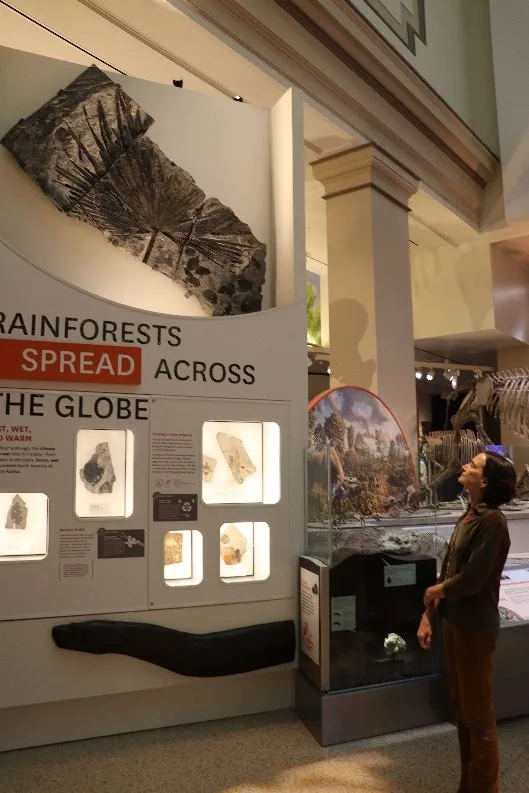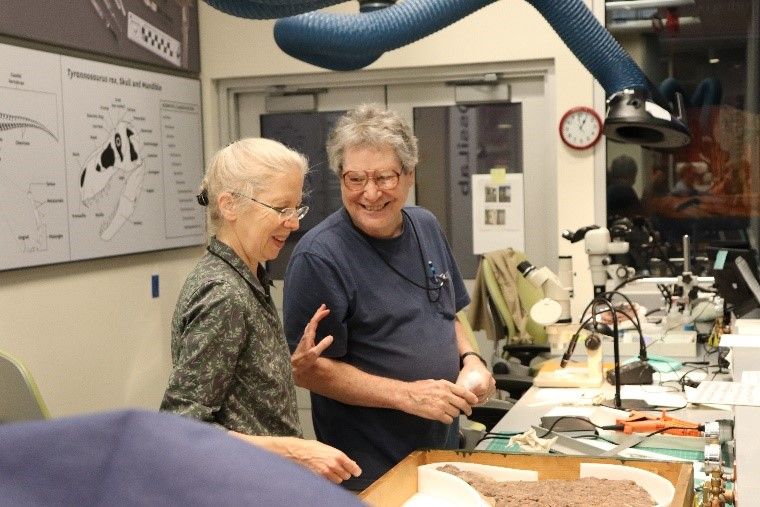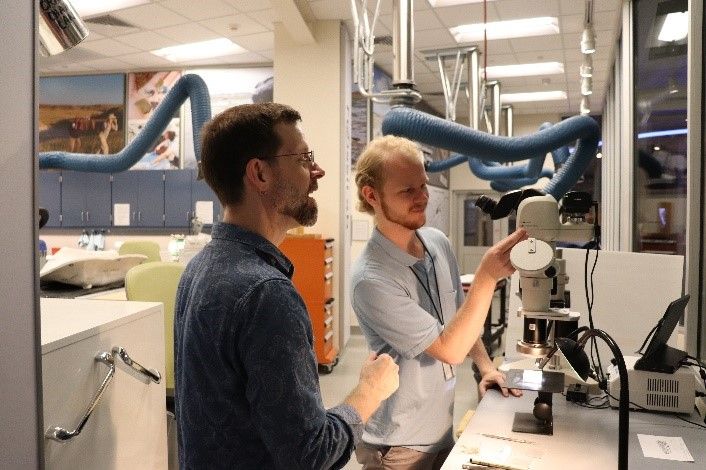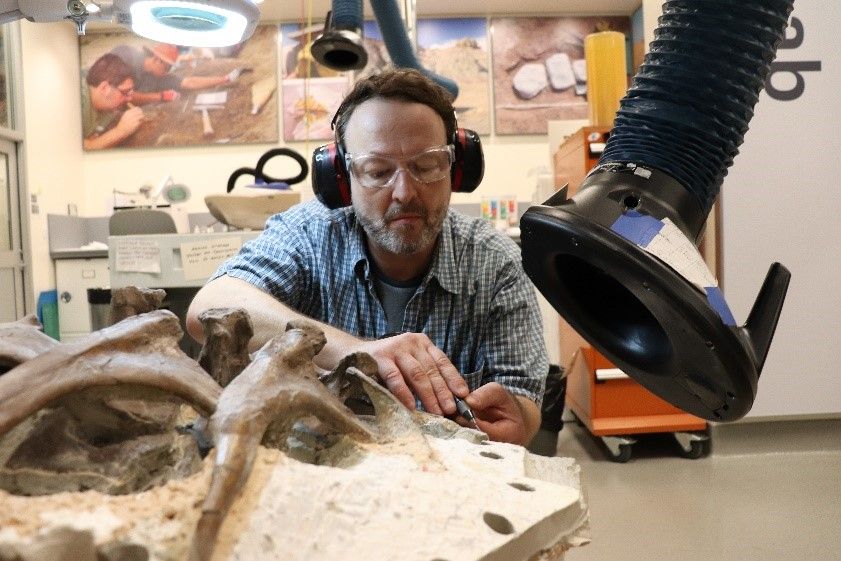NATIONAL MUSEUM OF NATURAL HISTORY
Smithsonian Puts Backstage Fossil Preparation Center Stage in its New Fossil Hall
Watch a team of volunteers prepare real fossils in the Smithsonian’s new fossil hall.
:focal(450x329:451x330)/https://tf-cmsv2-smithsonianmag-media.s3.amazonaws.com/blogging/featured/NMNH-2019-00823_2.jpg)
Whenever Hilary Cochard walks through the Smithsonian National Museum of Natural History’s new fossil hall exhibit, she gets to look up at a palm tree fossil from Alaska that she helped prepare for display and think “Oh, there it is.”
She isn’t museum staff or a paleontologist. She is one of many volunteers who dedicate their free time to helping the museum uncover and share the wealth of information hidden away in millions of fossils.
Fossils are essential to the museum’s mission. They help scientists understand the past — not just before recorded history but before humanity itself. They let us trace the tree of life and catch a glimpse of the many transformations our ever-changing world has undergone. And fossils spark children’s imaginations, planting a seed of excitement and passion for science. But before they can be displayed or studied, fossils have to be prepared and carefully stored — an often laborious, time-consuming process.

Visitors to the museum may not realize that the staff who prepare new fossil discoveries and care for the extensive collections relies on a team of committed volunteers for help. Whether they are freeing fossils fresh out of the field from surrounding rock or preparing to store specimens that have been on display for 100 years, the work requires a dedicated, focused effort to maintain precious information.
“The volunteers enable us to do things that we wouldn't be able to do otherwise,” says Abby Telfer, who manages the Smithsonian’s FossiLab and the volunteers who work there. “The labor involved in a lot of these tasks is enormous, and we don't have the staff to do it all without help. So, the volunteers have become a vital part of the process.”
Volunteers on display
Tucked between the "African Voices" exhibit and the fossil hall lies the FossiLab where both volunteers and staff work to prepare fossils in full view of any passing visitors. The walls composed of large windows put their work on full display and make some describe working in it as being in a “fish bowl.”
/https://tf-cmsv2-smithsonianmag-media.s3.amazonaws.com/filer_public/16/91/16916d34-264e-4210-a826-7c7b3a5debd5/nmnh-2019-00512.jpeg)
Digital displays of microscope views help visitors see the details of the work and whiteboards throughout the FossiLab share information about current projects. It is no exaggeration to say that the volunteers are a living exhibit as they prepare fossils for exhibit or study.
“The volunteers give science a face,” Telfer says. “Visitors can get a sense of what it looks like to do this type of science and that the people doing it look like them — we don't have lab coats here.”

The volunteers’ careful work shows visitors that the Smithsonian is much more than just its exhibits and that fossils are not all dinosaurs and other large animals. Their work is a peek into the millions of diverse fossils the Smithsonian holds in its collections, which are studied by scientists from all over the world.
Visitors may see volunteers doing a variety of things such as revealing large fossils with a chisel and hammer, sifting through sediment to find tiny fossils, cutting foam to house fossils and making scientific illustrations. These tasks often highlight fossils that don’t make it into exhibits and provide a glimpse into the research process.
Committed to the work
FossiLab’s team of volunteers usually consists of 35 to 45 individuals with only about five new volunteers-in-training most years. Volunteering for the FossiLab team is a long-term commitment since it takes a significant amount of time to master the work, learn one’s limits and become comfortable in the space.

“Some of the volunteers are scientists; some of them are not; some are retired; some work full time; some are college students,” Telfer says. “The main thing that they have in common is that they're patient, intensely focused and very good with their hands.”
When people in the lab start using tools such as an air scribe — imagine a small jackhammer made into a handheld, pen-shaped tool —the small space becomes incredibly noisy, both from the tools and the system used to minimize the dust in the air. Workers have to wear ear protection and have the dedication and focus to persist in their often delicate and monotonous tasks without letting distractions interfere.

Hunting for Treasures
Different workers develop different skills to support their assigned tasks and find their own rewards in the task. For some, it is the development of new skills; for others, it’s their contribution to a larger scientific endeavor.
Elizabeth Bruce spends her volunteer time sifting through sediment collected at sites where researchers found significant fossils in the hopes of finding smaller creatures that shared the same environment. The work helps researchers paint an in-depth picture of ancient ecosystems. It may seem tedious, but she gets to discover fossils that no one has seen before.
“I love hunting for treasures,” Bruce says. “And there are so many treasures in this sediment material even though they are tiny.”
Jerry Taylor who similarly searches through sediment compares the intermittent thrill of finding something in the sediment to playing Las Vegas slot machines. She also enjoys getting to see parents encouraging children’s excitement in the work she performs.
No matter their reason for sharing their time, each volunteer is a valuable part of the museum. They ensure that visitors get to see the humanity, rough edges and hard work that is so often hidden behind the pristine fossil exhibits.
Related stories:
Five Things You Shouldn’t Miss in the New Fossil Hall
The Experts Behind the New Fossil Hall Wrap Their Minds Around ‘Deep Time’
Try These Hands-on Activities in the Smithsonian’s New Fossil Hall
Old Fossils, New Meanings: Smithsonian Exhibit Explores the History of Life and What it Means for Our Future
A Smithsonian Dino-Celebrity Finally Tells All

